Moon Moves into Morning, Mars Migrates from Uranus, Minutes with Mercury in Evening, and a Look at Orion!

This terrific image of the sword of Orion was taken on January 7, 2019 by Rick Foster of Markham, Ontario. The colourful Messier 42 nebula is glowing by the light of young stars formed within it. The area shown here covers about 2 finger widths of the sky.
Hello, mid-winter stargazers!
Here are your Astronomy Skylights for the week of January 31st, 2021 by Chris Vaughan. Feel free to pass this along to your friends and send me your comments, questions, and suggested topics. You can also follow me on Twitter as @astrogeoguy! Unless otherwise noted, all times are expressed in Eastern Time. To subscribe to these emails please click this MailChimp link.
I can bring my Digital Starlab portable inflatable planetarium to your school or other daytime or evening event, or teach a session online. Contact me through AstroGeo.ca, and we’ll tour the Universe, or the Earth’s interior, together!
Groundhog Day marks mid-winter on Tuesday. The waning moon will pass third quarter at mid-week, placing it in the post-midnight and morning daylight sky. That allows for the evening zodiacal light to appear, and it leaves evenings around the world extra dark – for enjoying the sights of Orion, plus Mars and Uranus, and Mercury after sunset. Read on for your Skylights!
Groundhog Day
Well – Tuesday morning, February 2 is Groundhog Day! A cloudy day supposedly forecasts an early spring. But why does it fall on February 2 each year? That date is one of the four so-called cross-quarter days, which are the midpoints between the solstices and equinoxes. February 2 is exactly midway between the winter solstice and the vernal equinox – so we can expect the weather to start being more spring-like and less winter-like, whatever the local groundhog sees. Astronomers don’t care too much if spring comes early – as long as the skies are clear.
You can’t merely divide our 365.25-day year into four 91.3-day-long seasons and then count half that many days to reach the cross-quarters. Planets with elliptical orbits move faster when they are closer to the sun and slower when they are farther away. Since Earth is moving slower at aphelion in July, summers in the Northern Hemisphere are about five days longer than winters, which are a couple of days shorter than the average season-length. The true mid-point of winter will occur on Wednesday. But someone decided to establish Groundhog Day as February 2 – I guess to allow the media to plan thier coverage.
On February 2, Roman Catholics celebrate Candlemas. In contemporary paganism, the day is called Imbolc, a traditional time for initiations. The other three cross-quarter days are May Day (Beltane) on May 1, and Lughnasath or Lammas on August 1, and Samhain on November 1. I think you can guess which spooky “holiday” that last one connects to. Anyway – fingers crossed for cloudy skies on Tuesday, I guess.
Well – Tuesday morning, February 2 is Groundhog Day! (See what I did there? J)
Evening Zodiacal light
For about half an hour after full dusk during the two-week period preceding the new moon on February 11, look west for a broad wedge of faint light extending upwards from the horizon and centered on the ecliptic. That glow is the zodiacal light – sunlight scattered from countless small particles of material that are sprinkled throughout the plane of our solar system. Try to observe the zodiacal light from a location without light pollution, and don’t confuse it with the brighter Milky Way, which extends upwards from the north-northwestern evening horizon at this time of year.
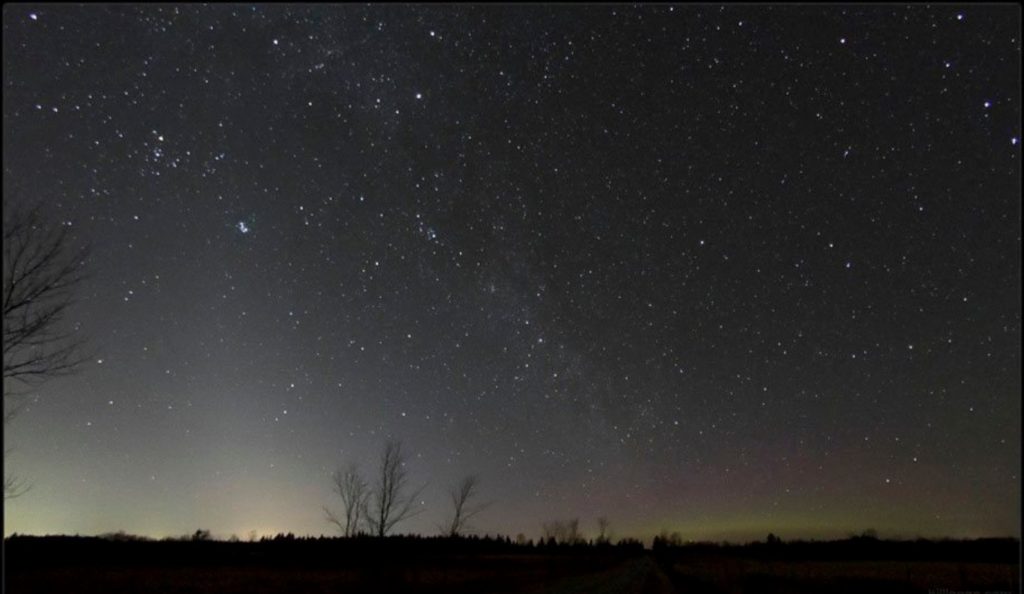
The Moon
This will be the week of the lunar month when our “celestial satellite” the moon will shine brightly in the late-night and pre-dawn sky, and then linger to shine like the ghost of night in the morning daytime.
When the waning gibbous (i.e., more than half-illuminated) moon rises tonight at about 9 pm local time, it will be positioned among the medium-bright stars that mark the head and shoulders of the Maiden, Virgo. The moon will take two more nights to traverse Virgo’s lengthy form, passing a palm’s width to the left (celestial north) of her brightest star, magnitude 0.95 Spica from late Tuesday night to Wednesday morning.
Visible between midnight and dawn on both Thursday and Friday, the moon will shine among the stars of Libra (the Scales). The moon will formally reach its third quarter phase at 12:37 pm EST, or 17:37 Greenwich Mean Time, on Thursday. At this phase the moon is half-illuminated, on its western (left-hand) side – towards the pre-dawn sun. Wherever you live, the moon will rise in the middle of the night, and then remain visible in the southern sky all morning. Third quarter moons are positioned ahead of the Earth in our trip around the Sun. About 3½ hours later, Earth will occupy that same location in space. The week of moonless evening skies that follow third quarter will be ideal for observing deep sky targets.
On Saturday, early risers can look in the southeastern pre-dawn sky for the waning crescent moon sitting prettily just a few fingers widths to the upper left (or 4.5° to the celestial north) of the bright star Antares, which marks the ruby-red heart of Scorpius (the Scorpion). And on Sunday morning, the moon will slide east to shine just a finger’s width below a modest star designated c Ophiuchi. That star marks the outstretched foot of the Serpent-Bearer, Ophiuchus. The rest of that large constellation extends upwards from the bright star Sabik (or Eta Ophiuchi), which you’ll find a fist’s diameter above the moon.
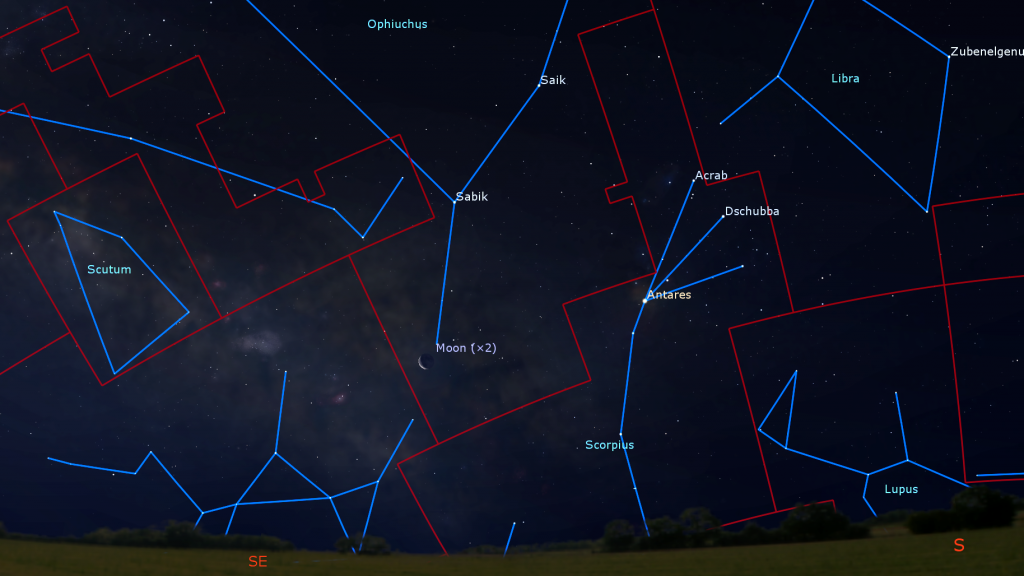
By the February 6-7 weekend, the moon will be in the daytime sky all morning long. Don’t forget that you can safely view the moon in daytime through your binoculars and telescopes – as long as you are careful not to let anyone aim the optics towards the sun. To improve the view, try wearing polarized 3D glasses while looking and rotate your viewing angle until the sky darkens.
The Planets
As I mentioned last week, we’re entering a planet-viewing drought, because nearly all the planets will be gathering in the eastern predawn sky – and too close to the sun to easily see them. Venus will return to view in the western sky after sunset from late April onwards – but Jupiter and Saturn won’t return to the evening sky until June. For folks who have just bought telescopes, it’s a good time to learn about other types of objects to look at. (Some suggestions in Orion are described below.)

From Sunday to mid-week, Mercury will be visible for a short period after sunset – but you’ll need an unobstructed view of the west-southwestern horizon, and cloudless skies. Tonight (Sunday) you can look for the speedy planet from about 6 pm in your local time zone, when it will sit about a palm’s diameter above the horizon, to 6:15 pm, when it will be lower. Be sure that the sun has completely disappeared below the horizon before you search for Mercury with binoculars.
Mars is still available for evening viewing after dusk every night, but it is getting fainter, and smaller in telescopes, with each passing week. The medium-bright, reddish dot of Mars will be located more than halfway up the southern sky at dusk. Then it will descend all evening and set at about 1:30 am local time. Look for the two brightest stars of Aries (the Ram) sitting to the upper right (10 degrees to the celestial north) of Mars. Hamal is brighter, at magnitude 2.0, and Sheratan is a bit fainter at magnitude 2.6.
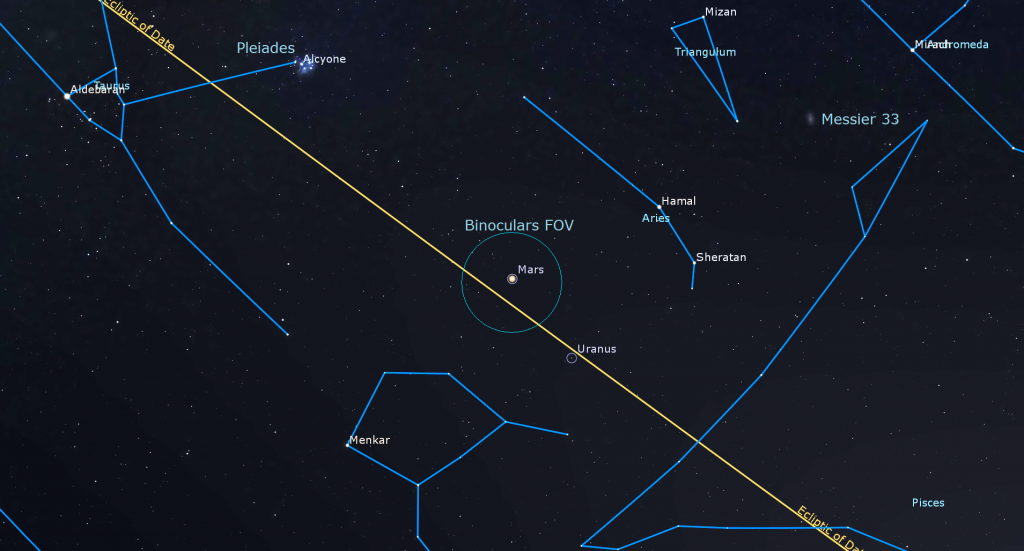
Tonight, January 31, dim and distant Uranus is located about a palm’s width below Mars. By next Sunday, that gap will increase to nearly a fist’s diameter. View Uranus earlier in the evening when it’s higher in the sky and seen through less of Earth’s distorting atmosphere. In a telescope, Uranus will resemble the stars near it – but the planet won’t twinkle as much as they do, and it will show a blue-green colour.
Awesome Orion
Every year during winter, the southern evening sky is dominated by the eye-catching constellation of Orion (the Hunter) and his famous three-starred belt. Orion contains some of the sky’s most spectacular sights – whether you are using your unaided eyes, binoculars, or telescopes of any size! Orion’s spectacular stars, and the bright nebulas in his sword and belt, make cold winter nights much more rewarding for skywatchers. So let’s bundle up against the winter chill and take a tour of the hunter!
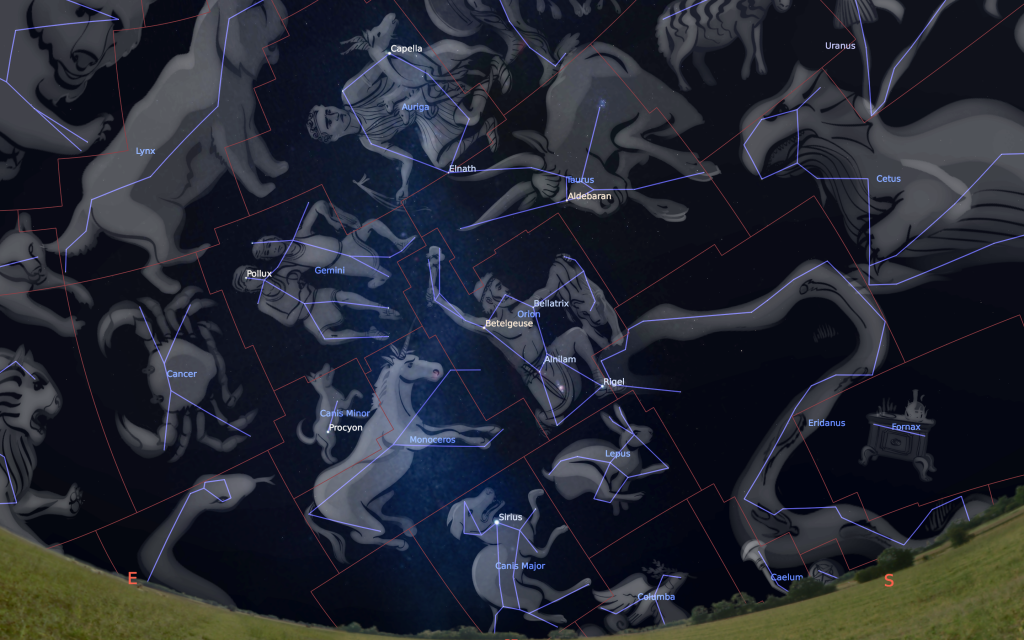
The constellation of Orion is well-known for several reasons. It straddles the Celestial Equator, making it visible from both the Northern and Southern Hemispheres. Most of its stars are bright enough to see with unaided eyes, even under light-polluted skies. And the constellation obviously represents a human figure.
Orion is surrounded by Taurus (the Bull) to his upper right (celestial northwest), Gemini (the Twins) to his upper left (northeast), Monoceros (the Unicorn) on his left (east), Lepus (the Rabbit) below him (south), and Eridanus (the River) towards his lower right (southwest).

He has traditionally been depicted as kneeling. His eastern arm is raised and holds a club. His western arm is outstretched, and his hand holds a lion’s pelt, or a shield. Orion is a medium-sized constellation measuring about 30° (or three outstretched fist widths) from the tip of his club to his toes or knees, and 20° from his eastern elbow to the lion’s pelt. In early evening, Orion is halfway up the southeastern sky, his head tilted a little to the left. (That’s toward the left for observers viewing him in the Northern Hemisphere.) As the evening wears on, Orion rises higher and stands upright. In early February, he sets at about 3 am local time.
The constellation was recorded by Babylonians as the Heavenly Shepherd (where his club is a crook). The Egyptians added the stars of Lepus to form the god Sah, which was associated with the deity representing the star Sirius. The muslims called him “al-jabbar” the giant. The Polynesians saw a Cat’s Cradle game in Orion’s stars. The Maori incorporated Orion’s belt into the stern of their great war canoe, Te Waka O Tamarereti.
In Greek mythology, Orion was Prion the hunter, the son of Poseidon. When Prion threatened to hunt and kill all the animals in the world, Earth-mother Gaia sent Scorpius to sting him to death. But Ophiuchus (the Water-Bearer) used medicine to save Prion. Now, Orion and Scorpius sit on opposite sides of the sky. Orion is in the winter evening sky and Scorpius is in the winter morning sky – with Ophiuchus stepping on the scorpion from above. Orion is mentioned several times in the Bible, and as Menelvagor “the Swordsman of the Sky” in Lord of the Rings.

The Ojibwe and related indigenous groups of North America associate Orion’s stars with the constellation of Biboonikeonini, the Winter-Maker. They envision him with longer arms – so that his hands hold the bright stars Procyon on the east and Aldebaran on the west.
Not surprisingly, many cultures have also assigned meaning to the distinctive row of three regularly spaced stars that mark Orion’s Belt. Scandinavian countries have seen a distaff, a scythe, and a sword. Predominantly Catholic countries referred to those three stars as The Three Mary’s (as featured in the New Testament). In the Middle East, his belt has been identified as The Three Kings or Magi. In China, it is known as The Weighing Beam and the Three Stars. In fact, the top portion of the Chinese character, 參 (shēn) has three identical symbols representing those three stars. The Lakota people called his belt the Bison’s Spine – with surrounding stars and nearby constellations forming the rest of a great bison in their winter sky. When viewed from the Southern Hemisphere, Orion is upside-down – and his belt and sword combine to form the shape of a frying pan! Try bending over and looking at him upside-down.
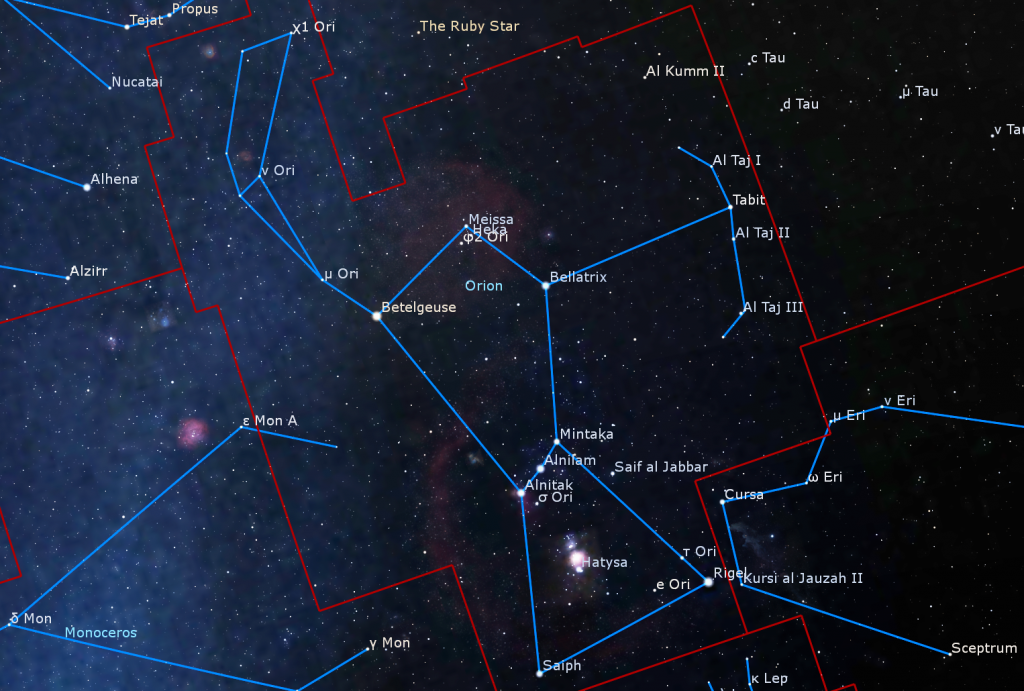
From left to right (or east to west in the Northern Hemisphere), the three belt stars are named Alnitak, Alnilam, and Mintaka. While they appear similar, Alnitak is bluer, Mintaka is dimmer, and Alnilam is MUCH farther away.
In a telescope, Alnitak (Arabic for “the Girdle”) is revealed to be a very tight double star. The larger, main star of Alnitak’s pair is a blue supergiant star located about 820 light-years from our solar system. The star emits tremendous amounts of ultraviolet light. Its surface temperature is a scorching 31,000 Kelvins, which is essentially the same as 31,000° C at those extremes! For comparison, our little yellow sun’s temperature is a mere 6,200 K! Its dimmer partner is orbiting the main star once every 1500 years!
The belt’s middle star, Alnilam (“String of Pearls”), is another large and very hot, blue-white star. It’s located about twice as far away from us than the two other belt stars. Aging rapidly and nearing the end of its hydrogen supply, Alnilam is expected to become a red supergiant, the pre-cursor to a supernova blast, at any time. And since the star is more than 1,900 light years away from us – that explosion may already have happened!
The belt’s westernmost star, called Mintaka (“Belt”), is also a double star when viewed in a telescope. In fact, there are at least four stars making up what we see as Mintaka. The brightest one has a partner that orbits it every 5.73 days in an eclipsing binary configuration that causes the star to vary in brightness. The dominant stars in Mintaka’s family gathering are also hot, blue giants. The group is located about 900 light years away from our solar system. If you look carefully, Mintaka is actually quite a bit dimmer than Alnitak and Alnilam. At the same time, look for a large, upright letter-S shape composed of dim stars in the space between Alnilam and Mintaka.
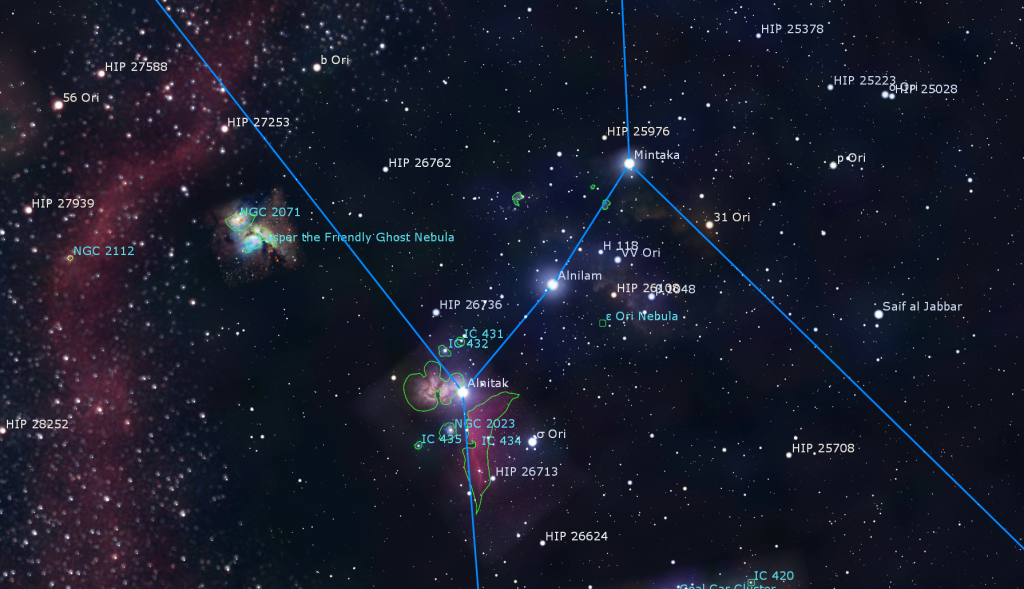
The bright, orange-coloured star named Betelgeuse marks Orion’s eastern armpit or shoulder. That funny-sounding name comes from the Arabic expressions “Ibṭ al-Jauzā”, meaning “the Armpit of Jauza”, or “Yad al-Jauzā”, “the Hand of Jauza”. Jauza was the Arabic name for the person the Arabs saw depicted in the Orion constellation. In Chinese, Betelgeuse is called 参宿四 Sānsù Sì, which translates to “The Fourth Star of the constellation of Three Stars”.
Betelgeuse is a red supergiant star located about 500 light-years away. If Betelgeuse replaced the sun in our solar system, all the inner planets out to Mars would be inside the star! Despite an age much less than our sun (it is of a type that matures dramatically faster), astronomers think Betelgeuse is approaching the end of its life. It is massive enough to explode as a Type II Supernova.
Normally, Betelgeuse ranks as the ninth brightest star in all the night sky. But in the winter of 2019-2020 it temporarily dimmed dramatically. While Betelgeuse has been known to dim and brighten throughout the many years that astronomers have been recording its brightness, this recent dimming was far below what is typically observed. Some thought we might be seeing indications that the end is near. After several months, it recovered its brightness. Astronomers now theorize that an encircling cloud of opaque dust temporarily passed in front of the star, dimming its light. Since it takes about 500 years for light to reach us from Betelgeuse, it could already have exploded! If it does go supernova, Earth is in no danger. We’ll just be treated to a spectacularly bright point of light for days or weeks.
The hot blue star sitting to the lower right (or southwest) of Orion’s belt is Rigel. Despite being located much farther away from us (about 860 light-years), Rigel is usually approximately the same visual brightness as Betelgeuse – meaning that Rigel emits considerably more visible light than Betelgeuse. Astronomers call this phenomena high luminosity. Rigel, too, is a supergiant star, and it has a surface temperature of 11,000 K! In a good telescope, a small companion star can be spotted very close beside Rigel. In Arabic, Rigel means “the Foot of the Great One”. In China, Rigel is known as 参宿七 (Sānsù Qī), “The Seventh of the Three Stars”.
Orion’s western shoulder is marked by the bright star Bellatrix, which translates as “Amazon Star”, after the warrior women of legend. Bellatrix is about 250 light years away from us, and burns at a blistering hot 21,500 K. It, too, is well along in its life cycle, and is expected to soon enter its next phase of evolution and turn an orange colour.
Above and between Orion’s shoulders is an open cluster of stars, 1,305 light-years distant, that forms his head. The brightest star in the group is named Meissa (“the Shining One”). Use binoculars or a telescope to enjoy them better, and see how many stars you can count. And try to magnify Meissa more to see its close partner. Some star charts call the cluster the Lambda Orionis Cluster, after Meissa’s Bayer designation.
Completing our circuit of Orion’s main body, the western foot or knee of Orion is the mis-named star Saiph or “Sword of the Giant”. Saiph is another hot, blue white star, with a surface temperature of 26,500 K, and it is also approaching the transition to creaky, old, red supergiant.
The lion’s pelt, or shield, that Orion is holding is composed of a crooked line of stars that run up and down off to Orion’s right-hand (or western) side. The brightest star, in the middle of the string, is named Tabit (“the Endurer”). This star’s Bayer designation is Pi Orionis. In fact, the entire row of stars are named π1 through π6 Orionis.
On the opposite side of the constellation, Orion’s upraised club dips into the Milky Way. As you move up the club, the pairs of stars that define it move wider apart. Use your binoculars to reveal the rich Milky Way star fields there.
We can use Orion’s stars as pointers to other ones. Extending the belt stars to the west leads to the bright, orange-ish star Aldebaran in Taurus, the Bull. Heading two fist diameters in the opposite direction leads you to the “Dog-star” Sirius, the brightest star in the entire night sky. A line drawn from Bellatrix to Betelgeuse points to Sirius’ bright puppy, the star Procyon. Finally, the line extending from Rigel up through Betelgeuse leads to the two matched stars Castor and Pollux, the heads of Gemini, the Twins.
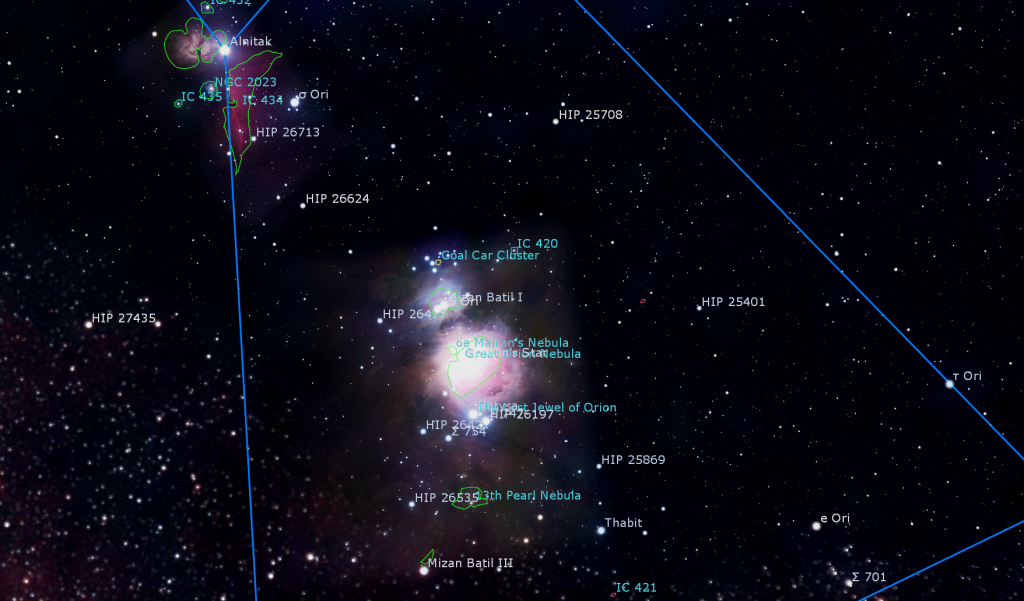
Orion’s spectacular sword is one of winter’s true astronomical treats. The sword is located a few finger widths below Orion’s belt. Unaided eyes can generally detect three patches of light in Orion’s sword, but binoculars or a telescope will reveal that the middle object is not a single star at all, but a bright knot of glowing gas and stars known as The Orion Nebula (or the Great Nebula in Orion, Messier 42, and M42).
The Orion Nebula is one of the brightest nebulae in the entire night sky and, at 1,400 light-years from Earth, it is one of the closest star-forming nurseries to us. It’s enormous. Under a very dark sky, the nebula can be traced over an area equivalent to four full moons! When you see knots of pink color in photos of other galaxies, you are seeing objects like M42.
Buried in the core of the Orion Nebula is a tight clump of stars collectively designated Theta Orionis (Orionis is Latin for “of Orion”), but better known as the Trapezium – because the brightest four stars occupy the corners of a trapezoid shape. Even a small telescope should be able to pick out this four-star asterism – but good seeing conditions and a larger aperture telescope will reveal two additional faint stars in the trapezium. The trapezium stars are hot, young O- and B-type stars that are emitting intense amounts of ultraviolet radiation. The radiation causes the Hydrogen gas they are embedded within to shine brightly as red light. At the same time, some of their light is scattered by surrounding dust, producing blue light. The combination of red and blue is why there is so much purple and pink in colour images of the nebula.
Within the nebula, astronomers have detected many young (about 100,000 years old) concentrations of collapsing gas called proplyds that should one day form solar systems. These objects give us a glimpse into how our own sun and planets formed.
Stargazers have long known about the trapezium stars in the nebula’s core, but detection of the nebulosity around them required the invention of telescopes in the early 1600’s. In the 1700’s, Charles Messier and Edmund Halley (both famous comet observers) noted the nebula in their growing catalogues of “fuzzy” objects. In 1880, amateur astronomer Henry Draper imaged the nebula through an 11-inch refractor telescope, making it the first deep sky object to be photographed.
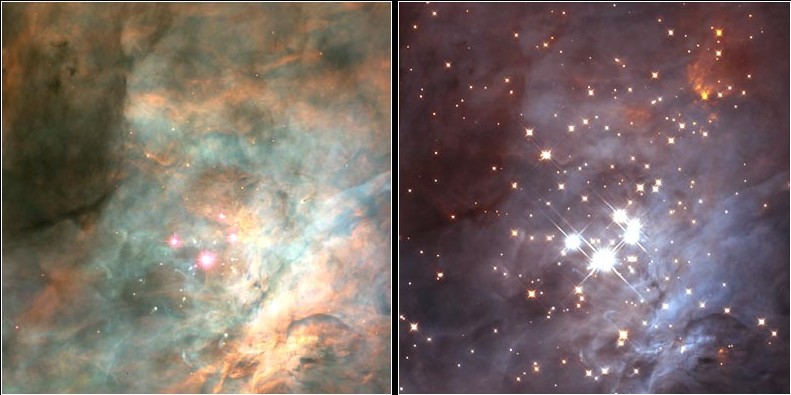
In your own small telescope, you should see the bright clump of trapezium stars surrounded by a ghostly grey shroud, complete with brighter veils and darker gaps. More photons would need to be delivered to your retina before colour would be observed, so try photographing it through your telescope, or using a camera/telephoto lens combination mounted on a tripod. Visually, start with low magnification and enjoy the extent of the cloud before zooming in on the tight asterism. Can you see four stars, or more? Just to the upper left of M42, you’ll find Messier 43, a separate lobe of the same nebula. It surrounds a naked-eye star named nu Orionis (or ν Ori).
While you’re touring the sword, look just below the nebula for a loose group of stars, located 1,300 light-years away from Earth, called Nair al Saif “the Bright One of the Sword”. The main star is a hot, bright star expected to explode in a supernova one day. It, too is surrounded by faint nebulosity. Astronomers believe that this star was gravitationally kicked out of the Hyades Cluster in Taurus about 2.5 million years ago.
Sweeping down the sword and toward the left (east) brings us to a star named Mizan Batil ath Thaalith (or d Orionis or 49 Orionis) at the tip of the sword. This magnitude 4.7 star is near the limit for visibility in moonless, suburban skies. About two finger widths to its right is another star of similar brightness, named Upsilon Orionis, or u Ori.
Moving upwards towards Orion’s belt, look half a finger’s width (or 30 arc-minutes – equal to the full moon’s diameter) above the Orion Nebula. Here you’ll find another clump of stars dominated by c Orionis and 45 Orionis. A larger telescope, or a long-exposure photograph, will reveal a bluish patch of nebulosity around them that contains darker lanes forming the shape of a figure, called the Running Man Nebula (NGC 1977). This is another case of dust and gas scattering blue light from those two stars.
Just above the Running Man sits a loose cluster of a few dozen stars called the Coal Car Cluster, or NGC 1981. It’s best seen in binoculars. Then we jump higher – most of the way towards Alnitak, the eastern-most (left-hand) belt star, to check out a beautiful little grouping of stars collectively called Sigma Orionis (σ Ori). What makes this a special treat is that, in a small telescope, we find about 10 stars the grouping. Check it out with your telescope – trust me, it’s a pretty sight! It’s a bit more than a finger’s width to the lower right of Alnitak.
Astrophotographers love imaging the area around Alnitak because it sits just to the west (or right-hand side) of the Milky Way, and is loaded with gorgeous gas clouds and nebulae. Alnitak and the brighter stars around it all host reflection nebulas – dim bluish haloes caused by starlight scattering off of dust.
Immediately below (south of) Alnitak is the famous Horsehead Nebula (or NGC 2023). It’s a cloud of hydrogen that is being energized by radiation from Alnitak, producing an elongated wedge of red light in long exposure images. The magic is the foreground patch of opaque dust that forms a sea-horse or chess-piece shaped silhouette on the nebula’s (left-hand) eastern edge. It’s not really visible visually – unless you have very dark skies and a very large aperture telescope.
Just to the left of Alnitak is another object called the Flame Nebula, also known as the Maple Leaf Nebula, Burning Bush Nebula, and NGC 2024. More energetic radiation from Alnitak is causing gas to glow. But this time, there’s a lot of dark dust mixed in, producing a unique shape.
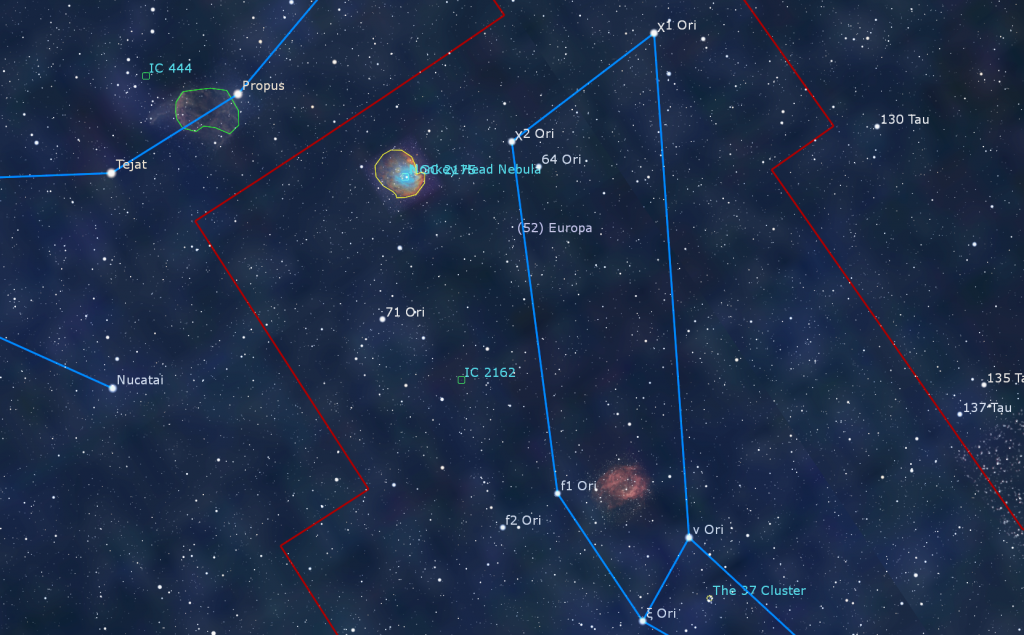
Several bright emission nebulas are clumped about two finger widths to the upper left (or celestial north) of Alnitak. The brightest of these is Messier 78, the Casper the Friendly Ghost Nebula. The young stars buried within the gas and dust are producing the pinkish emissions and bluish reflections. Another similar object called the Monkey Head Nebula (or NGC 2175) sits way up beside the tip of Orion’s club.
I think you’ll agree that Orion is indeed a celestial treat for everyone to enjoy!
Sirius and the Winter Football!
If you missed last week’s information about the bright star Sirius and the huge six-sided star pattern (or asterism) called the Winter Hexagon (or Winter Football, for NFL fans), I posted it here.
Public Astro-Themed Events
Every Monday evening, York University’s Allan I. Carswell Observatory runs an online star party – broadcasting views from four telescopes/cameras, answering viewer questions, and taking requests! Details are here. Their in-person Wednesday night viewing has been converted to online via the observatory Youtube channel, where they offer free online viewing through their rooftop telescopes, including their 1-metre telescope! Details are here.
My free, family-friendly Insider’s Guide to the Galaxy webcasts with Jenna Hinds of RASC National will return this Tuesday afternoon, February 2 at 3:30 pm EST. We’re going to lead you in trip through time – just by gazing up into the night sky! You can find more details, and the schedule of future sessions, here and here.
On Wednesday evening, February 3 at 7:30 pm EDT, the RASC Toronto Centre will live stream their monthly Recreational Astronomy Night Meeting at https://www.youtube.com/rasctoronto/live. Talks include the Sky This Month, do-it-yourself asteroid astrometry, and weather forecasting for astronomy. Details are here.
Our David Dunlap Observatory Saturday night events may be suspended at the moment, but we’re still pleased to offer the next best thing – online talks! On Saturday, February 6 at 7 pm EST, tune in to DDO Astronomy Night: Whispers from the Cosmos. Katie Breivik, a Flatiron Research Fellow at the Flatiron Institute’s Center for Computational Astrophysics, will discuss her work toward understanding how gravitational wave observations can be used to study how black holes and neutron stars form. More information and the registration link can be found here. The modest fee goes to support our ongoing efforts to deliver public programs at DDO.
On Sunday afternoon, February 28 from 1 to 2 pm I’m hosting an online session for RASC called Ask an Astronomer in support of the David Dunlap Observatory! We’ll explore the night sky together and answer your astronomy and space-related questions in simple language – using pictures, illustrations and planetarium software. The deadline to register is Friday February 26 at 3:00 pm. Registration is here. A modest fee goes to support our ongoing efforts to deliver public programs at DDO.
Keep looking up, and enjoy the sky when you do. I love questions and requests. Send me some!